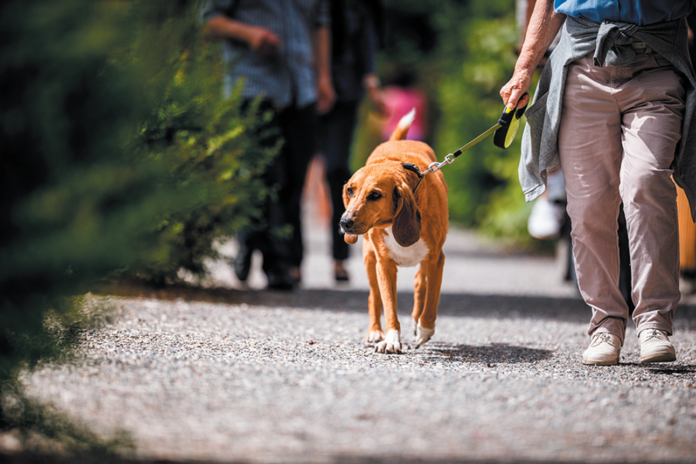While dogs in general are predisposed to liking people and may even have evolved to bond with us, that does not mean that every dog is interested in being petted by strangers with whom they happen to cross paths. That’s okay.
“A dog that’s not interested in people outside of her family or social group is perfectly normal,” says the head of the Tufts Animal Behavior Clinic, Stephanie Borns-Weil, DVM. “It’s as normal as you not wanting to shake hands with everybody you pass on the street.” You don’t have to worry that something’s wrong with your pet if she’s not a social butterfly with people she has never met or hardly knows.
“We have to move past this idea that dogs are public property,” the doctor says. “Dogs have boundaries. They should have agency and get a say in who handles them and how. The need to pet unfamiliar dogs is a human issue.”
Giving dogs agency is the responsibility of both their owners and the greater dog-loving community. Here’s how to respect dogs whether you are approaching the leash or holding it.
If you tend to be an enthusiastic greeter
People are often good about asking, “Can I pet your dog?” But it’s important to ask the dog, too, Dr. Borns-Weil says.
Begin by checking to see if the dog has shifted her weight away, started to lick her lips, or is looking from side to side rather than forward. Those are indications that she is not comfortable with the situation and should not be forced into a meet-and-greet.
If, on the other hand, the dog seems relaxed, stand next to her and drop your hand down beside her — not out toward her but close to your own body. If the dog comes forward, give a little scritch and a pet. Then stop. If the dog shows she wants more, perhaps by nosing you with her muzzle, keep going. If she doesn’t, let it go.
“Never take it personally if a dog doesn’t want to be petted,” Dr. Borns-Weil says. “There could be a million reasons that have nothing to do with you or even the dog’s temperament. Maybe she is picking up on the scent of something a half block away. Maybe she is thinking through something that happened yesterday. Maybe she is itchy or has an ear ache.”
Protecting your pet from unwanted interactions
When out with your pet, the first thing to always keep in mind is that you do not have to feel funny or embarrassed or apologetic if she doesn’t want to interact with someone she doesn’t know — or even with someone she does know. There are times she will have to deal with strangers handling her — at the vet’s, at the groomer’s. But when out for a recreational stroll, not wanting to engage is her prerogative, and everything should flow from that.
So what do you say when someone wants to pet your dog and you know she will not like it? A lot of people resort to “She’s not friendly,” which feels wrong — because it is. Your dog is friendly, right? Just not to strangers.
Instead, Dr. Borns-Weil suggests you might want to go with, “Thanks for asking. Actually, she’s uncomfortable around people.” Or “she’s fearful around people.” When you say that, the doctor explains, “you’re inviting people’s compassion to align with yours in the best interest of your dog.” They want to protect your dog right along with you.
You can also carry treats with you and say, “Let me give you a treat to toss for her.” It doesn’t mean the dog will suddenly want to interact with the stranger, but it will make her feel better, and the well-meaning dog lover, too.
Despite your protective efforts, Dr. Borns-Weil says, “some people will insist that they know more about what’s good for your dog than you do and try to interact despite your polite refusal. Since your job is to protect your pet, in those situations it’s important to simply disengage and move on.”
A couple of good stock lines to utter calmly but firmly:
“Not now, thanks. We’re training.”
“I’m sorry. We’re in a rush.” (Look at your phone.)
If both dog walkers and people happening upon dogs on the street took the dogs’ preferences about interacting into consideration, “there’d be a lot more comfort among dogs in general around unfamiliar people,” Dr. Borns-Weil says. “We’d even see fewer dog bites directed toward both strangers on the street and visitors in the home. Everybody would benefit by learning to accord dogs more respect for their space.”
This is the first in a three-part series about dogs who are uncomfortable socializing with strangers. In the March issue, we will discuss what to do for dogs whose fear of strangers is outside the boundaries of normal and could turn aggressive.





